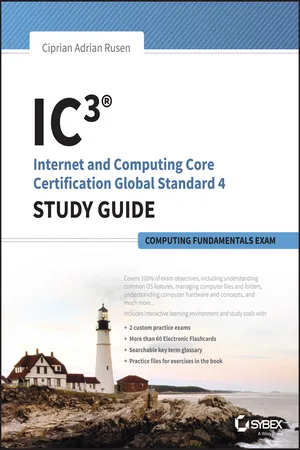
IC3: Internet and Computing Core Certification Computing Fundamentals Study Guide
- English
- ePUB (mobile friendly)
- Available on iOS & Android
IC3: Internet and Computing Core Certification Computing Fundamentals Study Guide
About this book
Test how well you know your way around a computer for the IC3 exam
IC3: Internet and Computing Core Certification Computing Fundamentals Study Guide is your ideal study guide to focus on the Computing Fundamentals exam module in preparation for the IC3 exam. This book covers hardware, software, peripherals, operating systems, and basic troubleshooting, presented in a clear, concise style. Hands-on examples and self-paced exercises show you how to perform critical tasks needed to pass the exam, and the companion website offers a diverse set of study tools including the Sybex test engine, a preassessment test, practice questions, and videos. Readers also gain access to electronic flashcards, and the chapter files needed to complete the exercises in the book.
This guide focuses on the Computing Fundamentals module helping you test your skills and solidify your understanding in preparation for the exam.
- Review the various hardware components essential to the computer
- Understand which peripherals are crucial, and which are nice to have
- Brush up on basic troubleshooting for common minor issues
- Master your operating system and fundamental software
When you are serious about certification, IC3 provides the practice that inspires self-confidence.
Frequently asked questions
- Essential is ideal for learners and professionals who enjoy exploring a wide range of subjects. Access the Essential Library with 800,000+ trusted titles and best-sellers across business, personal growth, and the humanities. Includes unlimited reading time and Standard Read Aloud voice.
- Complete: Perfect for advanced learners and researchers needing full, unrestricted access. Unlock 1.4M+ books across hundreds of subjects, including academic and specialized titles. The Complete Plan also includes advanced features like Premium Read Aloud and Research Assistant.
Please note we cannot support devices running on iOS 13 and Android 7 or earlier. Learn more about using the app.
Information
Chapter 1
Understanding Operating Systems
- ✓ What Is An OS And What Does It Do?
- Explain the differences between software applications and operating systems and demonstrate their uses.
- Common OS features, explain each of their uses:
- Power On/Power Off
- Log on/log off/switch user
- Lock/Unlock
- Differences between common OSs
- Explain how hardware can influence the Operating System and software and vice versa.
- Software updates, security fixes, bugs, adaptation to new hardware. Demonstrate how to update software, using manual and automatic settings.
- ✓ Manage Computer Files and Folders
- Directory and folder hierarchy and structure
- Menu, Toolbar, and Window Navigation
- Expand and Collapse
- Folder views
- File/Folder management
- Keyboard shortcuts
- Copy
- Paste
- Delete
- Move
- Rename
- Create shortcuts
- Search
- Identify file extensions and their associations such as .docx, .xlsx, .pdf, .mp3, etc.
- Directory and folder hierarchy and structure
- ✓ Manage Computer Configuration, Control Panel, OS, and Drivers
- Basic Desktop Customization
- Visual options
- Languages
- Date and Time
- Accessibility options
- Describe the various states of operation available in a typical consumer-level OS. Include Shutdown, hibernation, standby, fully awake, etc.
- User accounts and rights
- Group policy (specifically mobile)
- Read/Write
- Administrative vs. standard user rights
- File and Directory Permissions
- Basic Desktop Customization

Operating Systems and Their Roles When Using Computers and Devices
What Is Hardware?
What Is Software?
Table of contents
- Cover
- Title page
- Copyright
- About the Author
- Introduction
- Assessment Test
- Answers to Assessment Test
- Chapter 1 Understanding Operating Systems
- Chapter 2 Understanding Hardware
- Chapter 3 Understanding Software
- Chapter 4 Troubleshooting Problems with Your Computer
- Appendix A Answers to Review Questions
- Appendix B Using the Practice Files
- Advert
- EULA